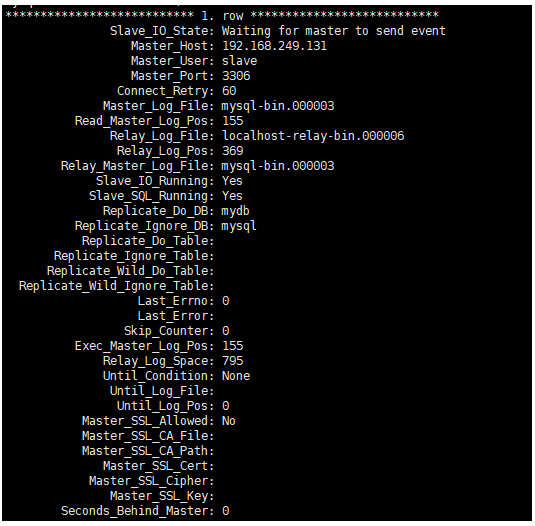您好,登錄后才能下訂單哦!
您好,登錄后才能下訂單哦!
這篇文章給大家介紹使用Springboot和Mysql8怎么實現一個讀寫分離功能,內容非常詳細,感興趣的小伙伴們可以參考借鑒,希望對大家能有所幫助。
準備兩臺虛擬機用作安裝mysql,并將下載后的文件mysql-8.0.16-linux-glibc2.12-x86_64.tar.xz上傳至服務器/app/mysql
192.168.249.131 CENTOS7 主
192.168.249.129 CENTOS7 從
查看防火墻狀態,如果啟動需要先關閉防火墻
service firewalld status ## 查看防火墻狀態 service firewalld stop ## 關閉防火墻 使用如下命令將xz文件解壓成tar文件 xz -d mysql-8.0.16-linux-glibc2.12-x86_64.tar.xz
解壓安裝包
tar -xvf mysql-8.0.16-linux-gl-ibc2.12-x86_64.tar
在/app/mysql下建立data文件夾,用于存放數據
創建mysql用戶組和mysql用戶
groupadd mysql ## 創建用戶組 useradd -g mysql -d /app/mysql mysql ## 在用戶組下創建mysql用戶并授權相關目錄 groupdel mysql ## 刪除用戶組名(若報已存在相關用戶組) userdel mysql ## 刪除用戶(若報已存在相關用戶)
初始化安裝mysql數據庫
./mysql-8.0.16-linux-glibc2.12-x86_64/bin/mysqld --user=mysql --basedir=/app/mysql --datadir=/app/mysql/data --initialize 2019-07-01T02:05:52.681626Z 0 [Warning] [MY-011070] [Server] 'Disabling symbolic links using --skip-symbolic-links (or equivalent) is the default. Consider not using this option as it' is deprecated and will be removed in a future release. 2019-07-01T02:05:52.681694Z 0 [System] [MY-013169] [Server] /app/mysql/mysql-8.0.16-linux-glibc2.12-x86_64/bin/mysqld (mysqld 8.0.16) initializing of server in progress as process 1479 2019-07-01T02:05:52.681726Z 0 [ERROR] [MY-010338] [Server] Can't find error-message file '/app/mysql/share/errmsg.sys'. Check error-message file location and 'lc-messages-dir' configuration directive. 2019-07-01T02:05:55.713747Z 5 [Note] [MY-010454] [Server] A temporary password is generated for root@localhost: xa6(H>rK/r<E 2019-07-01T02:05:57.303240Z 0 [System] [MY-013170] [Server] /app/mysql/mysql-8.0.16-linux-glibc2.12-x86_64/bin/mysqld (mysqld 8.0.16) initializing of server has completed
注意,此時mysql會生成一個默認的臨時密碼,如上所示,需要先保存下來然后修改
建立mysql服務并增加執行權限
cp mysql-8.0.16-linux-glibc2.12-x86_64/support-files/mysql.server /etc/init.d/mysqld
修改mysql配置文件 vi /etc/my.cnf 增加如下配置
[mysqld] port=3306 basedir=/app/mysql/mysql-8.0.16-linux-glibc2.12-x86_64 datadir=/app/mysql/data socket=/tmp/mysql.sock symbolic-links=0 [mysqld_safe] log-error=/app/mysql/data/log/error.log pid-file=/app/mysql/data/mysql.pid user=mysql tmpdir=/tmp character_set_server=utf8 default-storage-engine=INNODB init_connect='SET NAMES utf8' !includedir /etc/my.cnf.d
如果報日志權限相關錯誤,請先建立對應日志文件,并給mysql用戶授權
chown -R mysql:mysql /app/mysql/data/log/error.log
啟動mysql服務
service mysqld start
建立mysql客戶端軟連接
ln -s /app/mysql/mysql-8.0.16-linux-glibc2.12-x86_64/bin/mysql /usr/local/bin/mysql
登錄mysql修改密碼
mysql -uroot -p密碼 ## 登錄 ALTER USER 'root'@'localhost' IDENTIFIED WITH mysql_native_password BY '000000';
設置遠程登錄
use mysql; update user set host='%' where user='root' limit 1; flush privileges;
配置mysql主從同步(binlog)
復制原理
Master將數據改變記錄到二進制日志(binary log)中,也就是配置文件log-bin指定的文件,這些記錄叫做二進制日志事件(binary log events)
Slave通過I/O線程讀取Master中的binary log events并寫入到它的中繼日志(relay log)
Slave重做中繼日志中的事件,把中繼日志中的事件信息一條一條的在本地執行一次,完成數據在本地的存儲,從而實現將改變反映到它自己的數據(數據重放)
復制要求
主從服務器操作系統版本和位數一致
Master和Slave數據庫的版本要一致
Master和Slave數據庫中的數據要一致
Master開啟二進制日志,Master和Slave的server_id在局域網內必須唯一
配置步驟
主數據庫(192.168.249.131)
創建同步用戶并授權
CREATE USER 'slave'@'192.168.249.129' IDENTIFIED WITH 'mysql_native_password' BY '000000'; GRANT REPLICATION SLAVE, REPLICATION CLIENT ON *.* TO 'slave'@'192.168.249.129'; FLUSH PRIVILEGES;
注意這里創建用戶時需要選用mysql_native_password加密方式插件,否則默認會使用caching_sha2_password加密方式,這樣在同步的時候需要使用SSL的身份進行驗證,為了方便簡單,我們直接采用mysql_native_password方式
修改配置/etc/my.cnf,新增如下配置,開啟binlog,并重啟mysql服務
[mysqld] # 開啟二進制日志功能 log-bin=mysql-bin # 設置server_id,,注意在網段內要唯一 server-id=131 #(可選配置)要同步的數據庫名,要同步多個數據庫,就多加幾個replicate-db-db=數據庫名 binlog-do-db=mydb #(可選配置)要忽略的數據庫 binlog-ignore-db=mysql
查看主服務器狀態
show master status file

注意看里面的參數,特別前面兩個File和Position,在從服務器(Slave)配置主從關系會有用到的。
從數據庫(192.168.249.129)
修改/etc/my.cnf,新增如下配置,并重啟服務
[mysqld] server-id=129 log-bin=mysql-bin replicate-do-db=mydb replicate-ignore-db=mysql
在slave中設置master信息,指定同步位置
stop slave; change master to master_host='192.168.249.131',master_user='slave',master_password='000000',master_log_file='mysql-bin.000001',master_log_pos=155; start slave;
參數說明:
master_host='192.168.249.131' ## Master的IP地址
master_user='slave' ## 用于同步數據的用戶(在Master中授權的用戶)
master_password='000000' ## 同步數據用戶的密碼
master_port=3306 ## Master數據庫服務的端口
masterlogfile='mysql-bin.000001' ##指定Slave從哪個日志文件開始讀復制數據(Master上執行命令的結果的File字段)
masterlogpos=155 ## 從哪個POSITION號開始讀(Master上執行命令的結果的Position字段)
masterconnectretry=30 ##當重新建立主從連接時,如果連接建立失敗,間隔多久后重試。單位為秒,默認設置為60秒,同步延遲調優參數。
查看從服務器狀態
show slave status\G;

至此數據庫層面主從配置完成。
SpringBoot中配置主從讀寫分離
在主從模式下請遵守如下規則:
主數據庫 只執行 INSERT,UPDATE,DELETE 操作
從數據庫 只執行SELECT操作
我們這里使用開源項目[dynamic-datasource-spring-boot-starter](https://gitee.com/baomidou/dynamic-datasource-spring-boot-starter/wikis/)作為讀寫分離的工具包
使用方法
在mydb主數據庫中建立一個簡單數據表user,建好后從數據庫會自動同步
DROP TABLE IF EXISTS `user`; CREATE TABLE `user` ( `id` int(11) NOT NULL AUTO_INCREMENT, `account` varchar(255) COLLATE utf8mb4_unicode_ci DEFAULT NULL, `name` varchar(255) COLLATE utf8mb4_unicode_ci DEFAULT NULL, `position` varchar(255) COLLATE utf8mb4_unicode_ci DEFAULT NULL, PRIMARY KEY (`id`) ) ENGINE=InnoDB AUTO_INCREMENT=5 DEFAULT CHARSET=utf8mb4 COLLATE=utf8mb4_unicode_ci;
引入相關依賴
<dependencies> <dependency> <groupId>org.springframework.boot</groupId> <artifactId>spring-boot-starter</artifactId> </dependency> <dependency> <groupId>org.springframework.boot</groupId> <artifactId>spring-boot-starter-web</artifactId> </dependency> <dependency> <groupId>org.mybatis.spring.boot</groupId> <artifactId>mybatis-spring-boot-starter</artifactId> <version>2.0.1</version> </dependency> <dependency> <groupId>com.baomidou</groupId> <artifactId>dynamic-datasource-spring-boot-starter</artifactId> <version>2.5.5</version> </dependency> <dependency> <groupId>mysql</groupId> <artifactId>mysql-connector-java</artifactId> <version>8.0.15</version> </dependency> <dependency> <groupId>org.projectlombok</groupId> <artifactId>lombok</artifactId> <optional>true</optional> </dependency> <dependency> <groupId>org.springframework.boot</groupId> <artifactId>spring-boot-starter-test</artifactId> <scope>test</scope> </dependency> </dependencies>
配置數據源
spring: datasource: dynamic: primary: master #設置默認的數據源或者數據源組,默認值即為master strict: false #設置嚴格模式,默認false不啟動. 啟動后再為匹配到指定數據源時候回拋出異常,不啟動會使用默認數據源. datasource: master: type: com.zaxxer.hikari.HikariDataSource url: jdbc:mysql://192.168.249.131:3306/mydb?characterEncoding=utf8&zeroDateTimeBehavior=convertToNull&useSSL=false username: root password: '000000' driver-class-name: com.mysql.cj.jdbc.Driver slave_1: type: com.zaxxer.hikari.HikariDataSource url: jdbc:mysql://192.168.249.129:3306/mydb?characterEncoding=utf8&zeroDateTimeBehavior=convertToNull&useSSL=false username: root password: '000000' driver-class-name: com.mysql.cj.jdbc.Driver
在啟動類入口加入mybatis掃描包
@SpringBootApplication@MapperScan("com.jianzh6.dynamic.mapper")
public class DynamicDatsourceBootstrap {
public static void main(String[] args) {
SpringApplication.run(DynamicDatsourceBootstrap.class, args);
}
}建立實體類User
@Data
public class User {
private int id;
private String account;
private String name;
private String position;
}建立mapper接口文件,新增兩個方法addUser(User user),getById(int id)
public interface UserDao {
@Insert("INSERT INTO user(account, name, position) VALUES(#{account}, #{name}, #{position})")
@Options(useGeneratedKeys = true,keyProperty = "id")
int addUser(User user);
@Select("SELECT * FROM user WHERE id = #{id}")
User getById(int id);
}建立Service服務層相關實現
public interface UserService {
int addUser(User user);
User getById(int id);
}
@Service
public class UserServiceImpl implements UserService {
@Resource
private UserDao userDao;
@Override
public int addUser(User user) {
return userDao.addUser(user);
}
@DS("slave")
@Override
public User getById(int id) {
return userDao.getById(id);
}
}由于在數據源中配置了primary: master,默認操作都會從主庫執行,使用注解@DS切換數據源,此注解也可直接用于類文件上,同時存在方法注解優先于類上注解。
編寫單元測試進行測試
public class UserServiceTest extends DynamicDatsourceBootstrapTests {
@Autowired
private UserService userService;
@Test
public void testAddUser(){
User user = new User();
user.setName("李四");
user.setAccount("sili");
user.setPosition("JAVA開發工程師");
int i = userService.addUser(user);
System.out.println(user);
}
@Test
public void testGetById(){
int id = 4;
User user = userService.getById(id);
Assert.assertEquals("sanzhang",user.getAccount());
}
}關于使用Springboot和Mysql8怎么實現一個讀寫分離功能就分享到這里了,希望以上內容可以對大家有一定的幫助,可以學到更多知識。如果覺得文章不錯,可以把它分享出去讓更多的人看到。
免責聲明:本站發布的內容(圖片、視頻和文字)以原創、轉載和分享為主,文章觀點不代表本網站立場,如果涉及侵權請聯系站長郵箱:is@yisu.com進行舉報,并提供相關證據,一經查實,將立刻刪除涉嫌侵權內容。